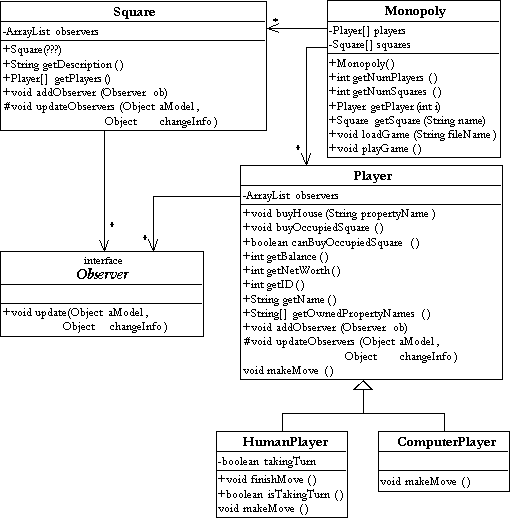Download a JBuilder project containing code to get you started:
monopoly.zip. The project contains two packages. monopoly.gui contains a graphical user interface (view and controllers) while monopoly.model will contain the model. Your early work will be exclusively in the
model.
About monopoly.gui
The code in monopoly.gui is complete and working. You should not modify it in any way until
after your program plays a legal game. In particular, most of the classes and
methods have package visibility rather than public visibility. You are not permitted to change this.
The user interface, monopoly.gui, requires that the model contain the following public classes with the
given public methods:
| Class/Method | Description |
| Square | A class representing a square on the board such as "Vermont Ave." or "Reading Railroad" or "Go". |
| getDescription | Returns a string describing the property. The string should contain newline characters ("\n") to format it into appropriate lines. |
| getPlayers | Returns an array containing the Players currently on this property. |
| addObserver | A method to add an observer that responds to changes to the property object. This code is provided. |
| Player | A class representing a player in the game. |
| getName | Returns a string containing the name of the player. |
| getOwnedPropertyNames | Returns an array filled with the names of the properties owned by this player. |
| getBalance | Returns an integer with the player's current bank balance. |
| getNetWorth | Returns an integer with the player's current net worth. |
| canBuyOccupiedSquare | Returns true if the player can buy the property they have landed on; false otherwise. |
| buyHouse | Instructs the player to purchase a house for a property. |
| buyOccupiedSquare | Instructs the player to purchase the property they just landed on. |
| addObserver | A method to add an observer that responds to changes to the property object. This code is provided. |
| Monopoly | A class representing the entire game. |
| playGame | A method that plays the game. When this method finishes, the game is over. |
| getNumPlayers | Returns the number of players in the game. |
| getNumSquares | Returns the number of squares on the board. |
| getPlayer | Returns the Player object specified by a parameter. |
| getSquare | Returns the Square object specified by a parameter. |
About monopoly.model
The model is where you will spend the vast majority of your time in
the first part of the project. The provided code includes the classes required
by the interface and stubs for the methods the user interface calls. A stub is
just enough for the program to compile -- if the method is a command, it will
be empty; if it's a query, it will return a constant such as false, 0 or null.
A class diagram showing the classes and methods required by the user interface is shown below. You will need to add several more classes and methods to the existing classes to make the program work as required.

Communication between the model and the user interface
Every time the model changes, the view (the display portion of the
user interface) must update the information it displays. The view is notified
of changes in the model when the model calls the view's update method. The view then queries the model for its current state and
redisplays itself. That is, it uses queries such as getBalance and getOwnedPropertyNames to find out what information it should display to the user.
The model is not one big thing -- it contains many distinct parts.
There are a relatively small number of Player objects and a larger number of Square objects. Similarly, the user interface is not a single, massive, view.
Parts of it are dedicated to displaying players while other parts are dedicated
to displaying squares. Each part of the model (each Player object and each Square object) keeps a list of observers that are concerned about changes to
that Player or Square object. Each observer has a method named update. When a model object changes, it should call the update method in each of the observers on its list. A view adds itself to the
list by calling the addObserver method in Player or Square.
The provided code includes a method, updateObservers (note the "s" at the end of the name), that calls the update method in each of the registered listeners. Call this method whenever
the model changes. For example, a method to change the bank balance might
be:
public void adjustBalance(int amt)
{ this.bankBalance += amt;
this.updateObservers(this, null);
}
The first parameter to updateObservers is always the model object that changed. The second parameter can
included additional information to be used by the view. It is often set to null.
One of the registered observers might be a PlayerView object. It has a method similar to this:
public void update(Object model, Object changeInfo)
{ if (model instanceof Player)
{ Player p = (Player)model;
this.balanceLabel.setText("$" + p.getBalance());
this.netWorthLabel.setText("$" + p.getNetWorth());
...
}
}